2003 Oldsmobile Alero parking brake
[x] Cancel search: parking brakePage 257 of 354
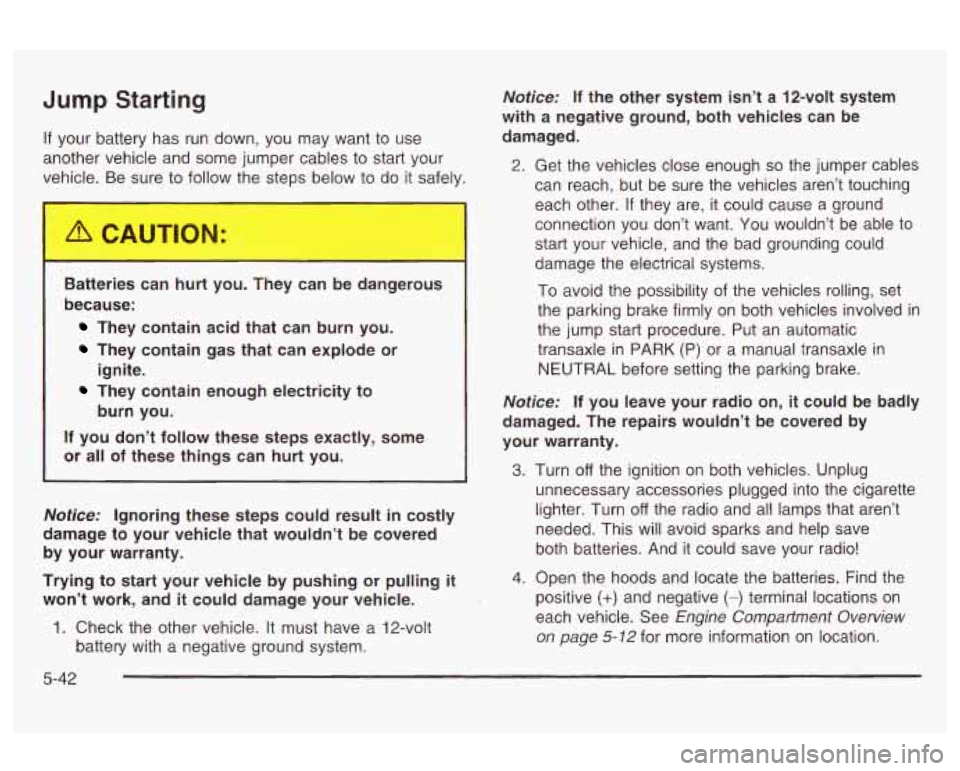
Jump Starting
If your battery has run down, you may want to use
another vehicle and some jumper cables to start your
vehicle. Be sure to follow the steps below to do it safely.
I- Ba..,ries can hi.- - you. ’_ --?y cal. Je c-.lgerous
because:
They contain acid that can burn you.
They contain gas that can explode or
They contain enough electricity to
ignite.
burn you.
If you don’t follow these steps exactly, some
or all of these things can hurt you.
Notice: Ignoring these steps could result in costly
damage to your vehicle that wouldn’t be covered
by your warranty.
Trying to start your vehicle by pushing or pulling
it
won’t work, and it could damage your vehicle.
1. Check the other vehicle. It must have a 12-volt
battery with a negative ground system.
Notice: If the other system isn’t a 12-volt system
with a negative ground, both vehicles can be
damaged.
2. Get the vehicles close enough so the jumper cables
can reach, but be sure the vehicles aren’t touching
each other.
If they are, it could cause a ground
connection you don’t want.
You wouldn’t be able to
start your vehicle, and the bad grounding could
damage the electrical systems.
To avoid the possibility of the vehicles rolling, set
the parking brake firmly on both vehicles involved in
the jump start procedure. Put an automatic
transaxle in PARK (P) or a manual transaxle in
NEUTRAL before setting the parking brake.
Notice: If you leave your radio on, it could be badly
damaged. The repairs wouldn’t be covered by
your warranty.
3. Turn off the ignition on both vehicles. Unplug
unnecessary accessories plugged into the cigarette
lighter. Turn
off the radio and all lamps that aren’t
needed. This will avoid sparks and help save
both batteries. And it could save your radio!
4. Open the hoods and locate the batteries. Find the
positive
(+) and negative (-) terminal locations on
each vehicle. See
Engine Compartment Overview
on page
5-12 for more information on location.
5-42
Page 265 of 354
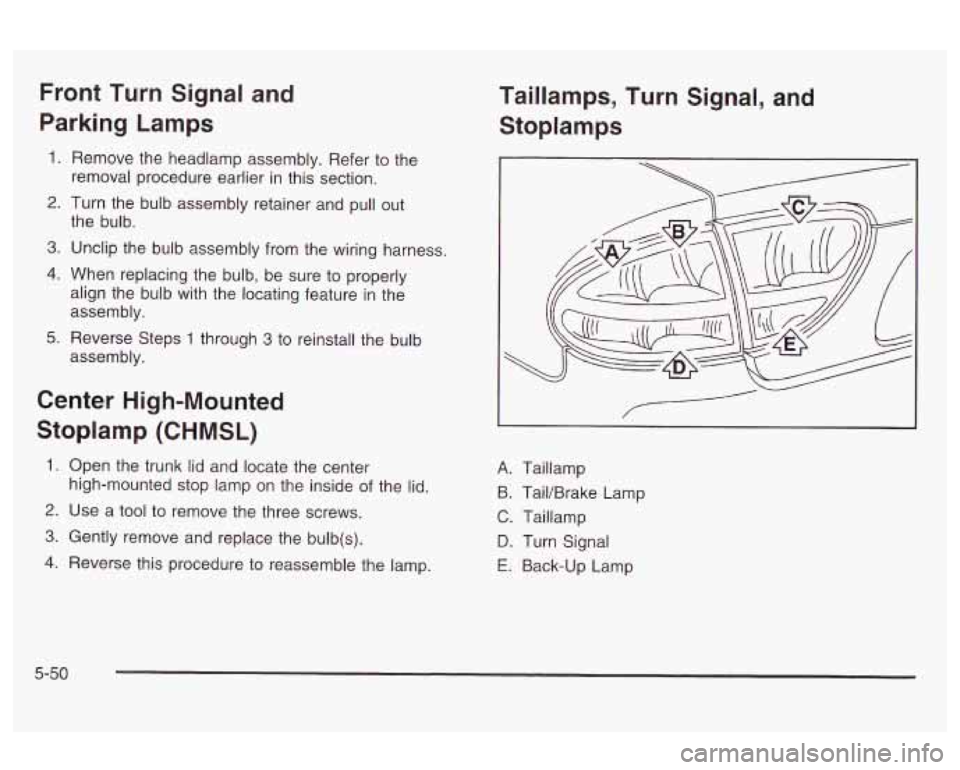
Front Turn Signal and
Parking Lamps
1. Remove the headlamp assembly. Refer to the
removal procedure earlier in this section.
2. Turn the bulb assembly retainer and pull out
the bulb.
3. Unclip the bulb assembly from the wiring harness.
4. When replacing the bulb, be sure to properly
align the bulb with the locating feature in the
assembly.
5. Reverse Steps 1 through 3 to reinstall the bulb
assembly.
Center High-Mounted
Stoplamp (CHMSL)
1. Open the trunk lid and locate the center
high-mounted stop lamp on the inside
of the lid.
2. Use a tool to remove the three screws.
3. Gently remove and replace the bulb(s).
4. Reverse this procedure to reassemble the lamp.
Taillamps, Turn Signal, and
Stoplamps
I /---
A. Taillamp
6. TaiVBrake Lamp
C. Taillamp
D. Turn Signal
E. Back-up Lamp
5-50
Page 277 of 354

Changing a Flat Tire
If a tire goes flat, avoid further tire and wheel damage
by driving slowly to a level place. Turn on your
hazard warning flashers.
Changing a tire can cause an injury. The
vehicle can slip
off the jack and roll over you
or other people. You and they could be badly
injured. Find a level place to change your tire.
To help prevent the vehicle from moving:
1. Set the parking brake firmly.
2. Put an automatic transaxle shift lever in
PARK (P), or shift a manual transaxle to
FIRST
(1) or REVERSE (R).
3. Turn off the engine.
To be even more certain the vehicle won't
move, you can put blocks at the front and
rear
of the tire farthest away from the one
being changed. That would be the tire on
the other side
of the vehicle, at the
opposite end. The following
steps will tell you how to use the jack and
change a tire.
5-62
Page 300 of 354
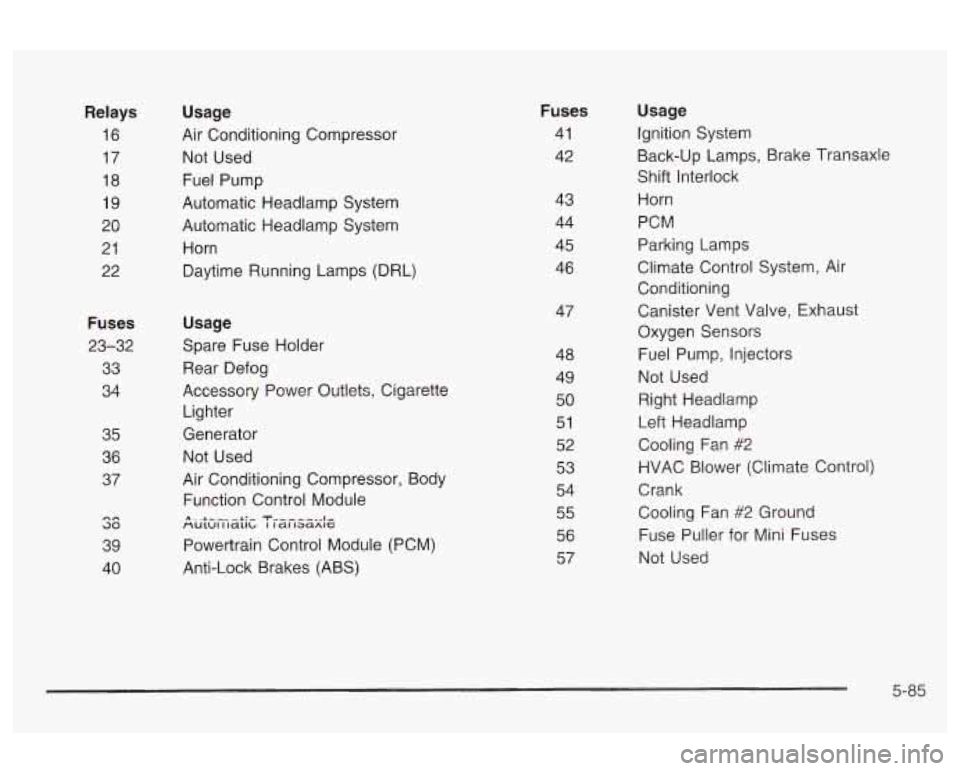
Relays 16
17
18
19
20 21
22
Fuses
23-32 33
34
35
36
37
36
39
40 Usage
Air Conditioning Compressor
Not Used
Fuel Pump
Automatic Headlamp System
Automatic Headlamp System
Horn
Daytime Running Lamps (DRL)
Usage
Spare Fuse Holder
Rear Defog
ACC~SSGP~ Power Outlets, Cigarette
Lighter
Generator Not Used
Air Conditioning Compressor, Body
Function Control Module
Powertrain Control Module (PCM)
Anti-Lock Brakes (ABS)
A ..I -._-- +:- T --.---., I, r\ULUI I Idllb I I C€l13C€AlG
Fuses 41
42
43
44
45
46 47
48 49
50
51
52
53
54
55
56
57 Usage
Ignition System
Back-up Lamps, Brake Transaxle
Shift Interlock
Horn
PCM
Parking Lamps
Climate Control System, Air
Conditioning
Canister Vent Valve, Exhaust
Oxygen Sensors
Fuel Pump, Injectors
Not Used
Right Headlamp
Left Headlamp
Cooling Fan
#2
HVAC Blower (Climate Control)
Crank Cooling Fan
#2 Ground
Fuse Puller for Mini Fuses
Not Used
5-85
Page 314 of 354
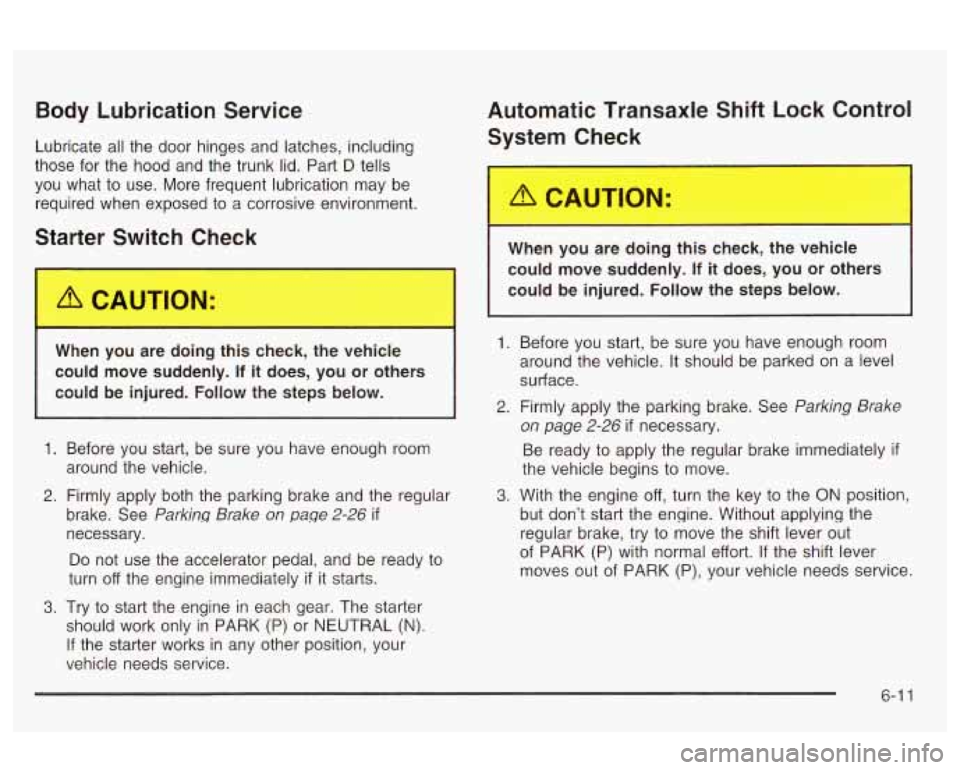
Body Lubrication Service
Lubricate all the door hinges and latches, including
those for the hood and the trunk lid. Part
D tells
you what to use. More frequent lubrication may be
required when exposed to a corrosive environment.
Starter S---:tc" Ct---'-
Automatic Transaxle Shift Lock Control
System Check
When you are doing this chec the vehicle
could move suddenly.
If it does, you or others
could be injured. Follow the steps below.
When you are doing this check, the vehicle
could move suddenly.
If it does, you or others
CGG!~ be i~j~d. FO~~GVV the steps below.
1. Before you start, be sure you have enough room
2. Firmly apply both the parking brake and the regular
around the vehicle.
brake. See
Parking Brake on page 2-26 if
necessary.
Do not use the accelerator pedal, and be ready to
turn
off the engine immediately if it starts.
3. Try to start the engine in each gear. The starter
should work only in PARK (P) or NEUTRAL (N).
If the starter works in any other position, your
vehicle needs service.
1. Before you start, be sure you have enough room
around the vehicle. It should be parked
on a level
surface.
2. Firmly apply the parking brake. See Parking Brake
on page
2-26 if necessary.
Be ready to apply the regular brake immediately
if
the vehicle begins to move.
but don't start the engine. Without applying the
regular brake, try to move the shift lever out
of PARK (P) with normal effort. If the shift lever
moves out of PARK (P), your vehicle needs service.
3. With the engine off, turn the key to the ON position,
6-1 1
Page 315 of 354
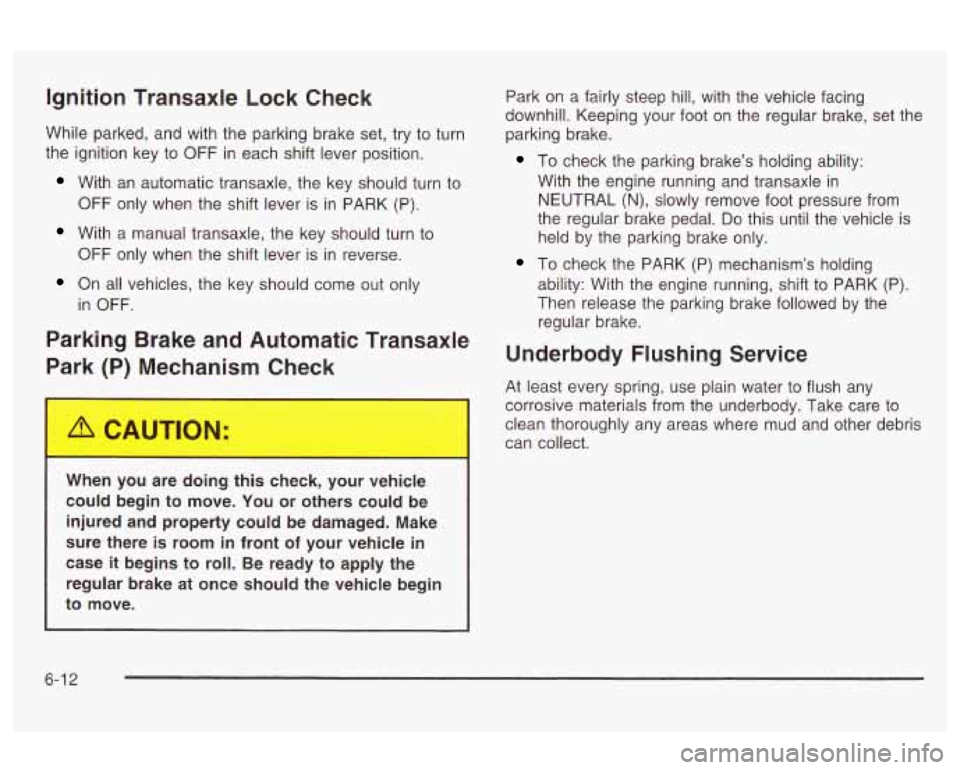
Ignition Transaxle Lock Check
While parked, and with the parking brake set, try to turn
the ignition key to
OFF in each shift lever position.
With an automatic transaxle, the key should turn to
OFF only when the shift lever is in PARK (P).
With a manual transaxle, the key should turn to
OFF only when the shift lever is in reverse.
On all vehicles, the key should come out only
in OFF.
Parking Brake and Automatic Transaxle
Parl- 'P) ""xhanism Check
Park on a fairly steep hill, with the vehicle facing
downhill. Keeping your foot on the regular brake, set the
parking brake.
To check the parking brake's holding ability:
With the engine running and transaxle in
NEUTRAL (N), slowly remove foot pressure from
the regular brake pedal.
Do this until the vehicle is
held by the parking brake only.
To check the PARK (P) mechanism's holding
ability: With the engine running, shift to PARK (P).
Then release the parking brake followed by the
regular brake.
Underbody Flushing Service
When you are doing this check, your vehicle
could begin to move. You or others could be
injured and property could be damaged. Make
sure there is room in front of your vehicle in
case it begins to roll. Be ready
to apply the
regular brake at once should the vehicle begin
to move.
I
At least every spring, use plain water to flush any
corrosive materials from the underbody. Take care to
clean thoroughly any areas where mud and other debris
can collect.
6-1 2
Page 317 of 354

Fuel System Inspection
Inspect the complete fuel system for damage or leaks.
Engine Cooling System Inspection
Inspect the hoses and have them replaced if they
are cracked, swollen or deteriorated. Inspect all pipes,
fittings and clamps; replace as needed. Clean the
outside of the radiator and air conditioning condenser.
To help ensure proper operation, a pressure test of
the cooling system and pressure cap is recommended
at least once a year.
Throttle System Inspection
Inspect the throttle system for interference or binding,
and for damaged or missing parts. Replace parts
as needed. Replace any components that have high
effort or excessive wear.
Do not lubricate accelerator
and cruise control cables.
Brake System Inspection
Inspect the complete system. Inspect brake lines and
hoses for proper hook-up, binding, leaks, cracks,
chafing, etc. Inspect disc brake pads for wear and rotors
for surface condition. Inspect other brake parts,
including calipers, parking brake, etc. You may need to
have your brakes inspected more often
if your driving
habits or conditions result in frequent braking.
6-1 4
Page 335 of 354
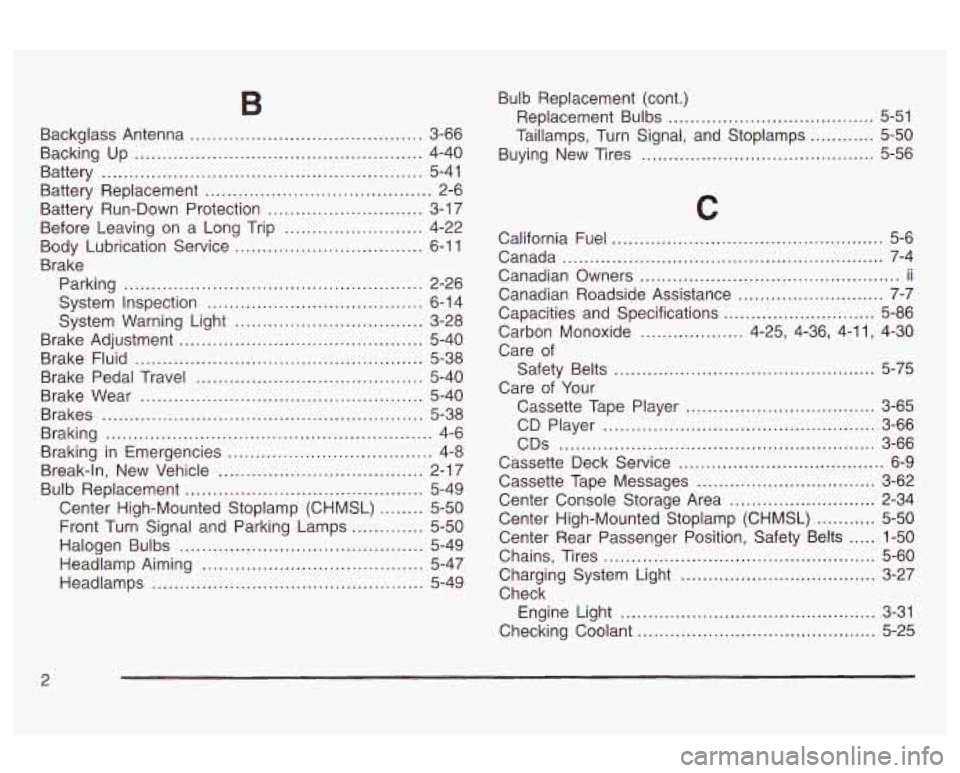
Backglass Antenna .......................................... 3-66
Backing Up
.................................................... 4-40
Battery
.......................................................... 5-41
Battery Replacement
......................................... 2-6
Battery Run-Down Protection
............................ 3-1 7
Before Leaving on a Long Trip
......................... 4-22
Body Lubrication Service
.................................. 6-1 1
Brake
Parking
................................... .... 2-26
System Inspection
.................... .... 6-14
System Warning Light
................... .... 3-28
Brake Adjustment
............................................ 5-40
Brake Fluid
.................................................... 5-38
Brake Pedal Travel
......................................... 5-40
Brake Wear
................................................... 5-40
Brakes
................................ ................... 5-38
Braking
................................... ................. 4-6
Break-in, New Vehicle
..................................... 2-17
Bulb Replacement
........................................... 5-49
Center High-Mounted Stoplamp (CHMSL)
........ 5-50
Front Turn Signal and Parking Lamps ............. 5-50
Headlamp Aiming .. .......................... 5-47
Braking
in Emergencies
............. ............. 4-8
Halogen Bulbs
............................................ 5-49
Headlamps
........ .......................... 5-49 Bulb
Replacement (cont.)
Replacement Bulbs
...................................... 5-51
Taillamps, Turn Signal. and Stoplamps ............ 5-50
Buying New Tires ........................................... 5-56
C
............
California Fuel ........................ ...... 5-6
Canada
......................................... .. 7-4
Canadian Owners
...............................
Canadian Roadside Assistance ........................... 7-7
Capacities and Specifications
............................ 5-86
Carbon Monoxide
................... 4.25. 4.36. 4-1 1. 4-30
Care
of
Safety Belts ........ ................ 5-75
Care of Your
..... II
Cassette Tape Player ... ................ 3-65
CD Player
.................................................. 3-66
Cassette Deck Service
...................................... 6-9
Center Console Storage Area
........................... 2-34
Center High-Mounted Stoplamp (CHMSL)
........... 5-50
Center Rear Passenger Position, Safety Belts ..... 1-50
Chains, Tires
.................................................. 5-60
Charging System Light
.................................... 3-27
Check Engine Light
............................................... 3-31
Checking Coolant
............................................ 5-25
CDS
.......................................................... 3-66
Cassette Tape Messages
................................. 3-62
3